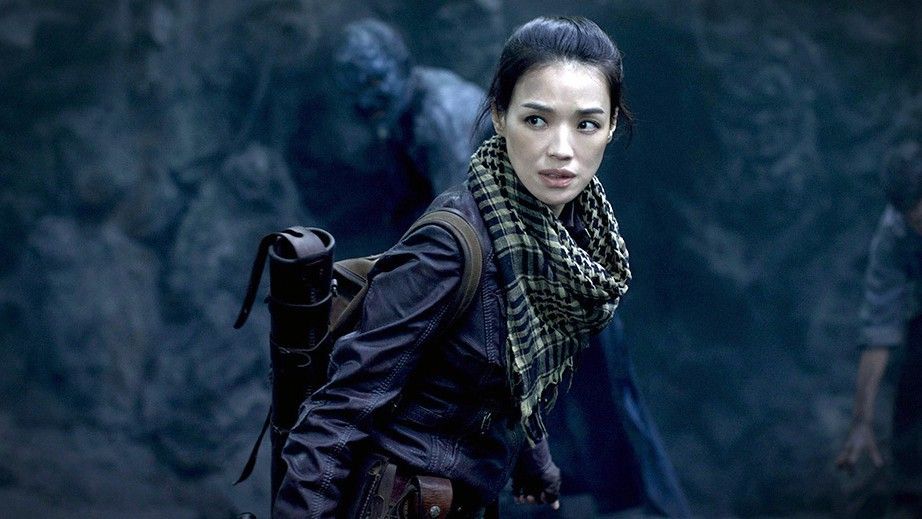Mojin: The Lost Legend (Wu Ershan, 2015)

International treasure Shu Qi stars in this blockbuster effects-driven film out of China, opening this week at the Pacific Place. One of a trio of grave robbers, Shu Qi and her compatriots Chen Kun and Huang Bo find themselves roped into a scheme to dig up a MacGuffin from an ancient tomb by a creepy cult leader and her armed gang of nobodies. Deadly traps, zombies, colored lights, and CGI adventure follow, with all the weightless, personality-free sheen of 21st century Chinese digital cinema. Directed by Wu Ershan, the man behind 2012’s Painted Skin: The Resurrection, Mojin has some potentially intriguing ideas at its core, but one has to dig deep to find them.
After a brief, contextless prologue, the film opens in New York in 1988, where the three treasure hunters have moved after quitting the tomb raiding game. Scrounging a living selling imitation artifacts on the street, the three are divided as to whether or not they should return to their calling, being as they are merely the latest in a line of Imperially-designated grave robbers, a line stretching back more than a thousand years. There’s also a romantic complication between Shu Qi and Chen (they slept together once but nothing came of it). Huang wants to find treasure and heads off on his own with the creepy cult types, then Chen and Shu Qi follow in order to rescue him. The location of the tomb in question turns out to be the same as one Chen and Huang had visited in their youth, which leads to a couple of extended flashbacks to 1968.
In the midst of the Cultural Revolution, the two men are assigned to remote Inner Mongolia, where they work on a collective and both fall in love with a beautiful, idealistic young singer, played by Angelababy. The first flashback shows how the young lunatic true believers of the collective heedlessly attacked a tomb, in the spirit of Maoist anti-superstition destruction, leading to an attack by a swarm of killer digital insects. A second flashback focuses on the romantic triangle between Huang, Chen, and Angelababy, and is shot in oversaturated colors: tonally it looks exactly like a Maoist propaganda poster. After an hour or so of underground exploration scenes in dull blue-gray, this shock of primary color is astounding and gorgeous. But we quickly return to the depths, with orange fire, green fire, and red fire.
The choice to set the film at the height of the Cultural Revolution, and make tangible its idealistic imagery and slogans (the tomb raiders’ motto echoes Communist calls for unity above all; every apparently supernatural effect in the tomb is given a scientific explanation — the party line is materialist: ghosts and zombies don’t exist — despite how ludicrous it makes most every action seem) while setting the present action on the eve of Tiananmen Square is obviously propagandistic, in a way that will surely appease the present government. But an allegorical reading proves more charitable. Chen and Huang are haunted by the tragedy of their idealized past, by the moment when Angelababy, the embodiment of the innocence of the Cultural Revolution, was lost to them. They’re locked in an unsustainable cycle of despair and regret. To move on and build a new, modern life with Shu Qi (her character is an American citizen, complete with the English name ‘Shirley’ and therefore avatar of the post-Tiananmen world to come) they must come to terms with the loss of faith that the turn Maoism took from idealism to mass death necessarily inspired. They have to give up on the idea that they can bring Angelababy back from the dead, that those old ideas can be resurrected. Or at least, learn to forget that they were ever lost in the first place. Given that so much of the film is a digital sludge of bad action, questionable plotting, and generic character dynamics, I’m not sure that this reading is justified. But stranger things have been smuggled within less accomplished genre fare. Tsui Hark, for example, has made innovative and exemplary adventure out of cartoonish Chinese CGI aesthetics (the Detective Dee films) as well as out of propaganda tales of the Cultural Revolution (The Taking of Tiger Mountain). Of course, Tsui Hark is one of the five greatest motion picture directors of the last 40 years. Wu Ershan is. . . not.
